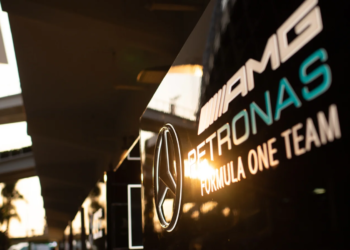Racing Point began the season scrapping for points but finished it firmly in the points as the groundwork was laid for its long-term aspirations. Motorsport Week reflects on the team’s 2019 campaign.
Having charged its way to lead the midfield on a shoestring budget Force India’s perilous predicament brought it to near collapse mid-2018. Under new ownership, and a new brand in Racing Point, it had a slow start followed by gradual progress as it focused on its long-term project.
If 2018 was turbulent for Force India then for the renamed but same-spirited organisation 2019 was the calm after the storm. Fourth, fourth and (if you combine the points tallies) sixth was followed by a more subdued seventh, but a quieter campaign was always expected given the legacy of the near-2018 collapse. Its regression to aiming for points – rather than regarding them as an expectation – highlighted how much it overachieved in recent seasons.
Watch: F1 v MotoGP – Hamilton and Rossi swap machinery
Racing Point began the year with a ‘vanilla’ car, in the words of technical chief Andrew Green, and that left it behind the development curve in a competitive midfield contingent. When the RP19 was being created Force India was still facing an uncertain future and thus the team had to adopt a relatively conservative stance. Early points – usually profiting from mistakes elsewhere – assisted the team’s cause but a slump set in, rescued only by Lance Stroll’s fourth in the Germany chaos. Sergio Perez endured the longest points drought of his career amid misfortune, a few incidents and rear-end instability from the RP19.
.jpg)
But a three-part upgrade package revitalised Racing Point’s flagging fortunes and rejuvenated Perez’s drifting season. The RP19 appeared in Germany with aggressively revised sidepods, courtesy of long-awaited revisions to the cooling package, while a few days later in Hungary the overhauled front suspension had been readied. A revised front wing was the most notable component of a raft of new bits that were brought to Singapore. Perez retired from that event but scored points at each race thereafter as Racing Point was thrust back into contention, having performed well at traditional strong grounds in Belgium and Italy. Perez’s ability to massage the tyres and coax performance from them, sometimes running alternative strategies, remained a strong asset.
“Already the package that we started in Germany, then we finalised it in Singapore, that was a big performance uplift for us,” said Stroll on Racing Point’s gains. “I don’t think we were in a position to compete with teams like Renault before the upgrade came, and that showed throughout the summer in Europe, we weren’t coring points very often, I had the big points score in Germany – but that was due to the conditions – before that I think it was Canada. There was a period of like six or seven races where we weren’t scoring points, then we brought the upgrade and it’s been much better. Especially going into next year, we can see improvements and that’s really what you want to see.”
Racing Point made impressive mid-season gains, considering its starting point, but one crucial element that needs attention is qualifying pace. Opportunities were missed through lacklustre grid positions. Stroll, a downgrade on Esteban Ocon, was a regular Q1 victim and had comfortably the worst average starting place of any midfield driver, while Perez made just four Q3 appearances, compared to 10 times in 2018. Good starts, particularly from Stroll, and nailing alternative strategies, a Perez speciality, just can’t always pay off.
.jpg)
“I think qualifying hasn’t been as strong but race-pace has been very strong as usual,” said Perez. “I think it’s some fundamental thing with the car, it’s been very difficult on new tyres. It’s been so bad you cannot improve. And it has been so much circuit-related this year, some we were strong and others we were really bad. That midfield group was so tight that two tenths in one sector would put you off.”
A sign of Racing Point’s intent was highlighted by Perez committing his long-term future to the team, penning a deal through 2022. The partnership, which stretches back to 2014, is ideal for both parties, giving them stability and a firm understanding of the respective goals.
“I think definitely it’s a massive opportunity for me to grow together for the future and obviously there is a big change in rules coming up so hopefully this team can be in place for that,” Perez said earlier in the year. “I wanted a project that motivated me, and it’s what I have here. I see a good future. Only time will tell if it’s right or not but I’m optimistic for it.”
Perez’s three-year commitment was not Racing Point’s only off-track development. One of Lawrence Stroll’s first moves was to give the green light to new facilities at its Silverstone base, with the local council having approved plans for a new factory that is due to open in mid-2021. It has already moved aero development into Mercedes’ wind-tunnel in nearby Brackley. At the track it introduced a new three-storey motorhome that took its place among the leaders and gave a freshness lacking from some other teams. The message was clear: this is a new and bold era for the team.
Racing Point will need to maximise its new facilities in order to keep pace with its midfield opponents and tangible gains may take years to arrive. But after over-achieving, and almost going under, its transition season brought much-desired stability, and it now has a platform on which to build moving forward.
.jpg)







Discussion about this post